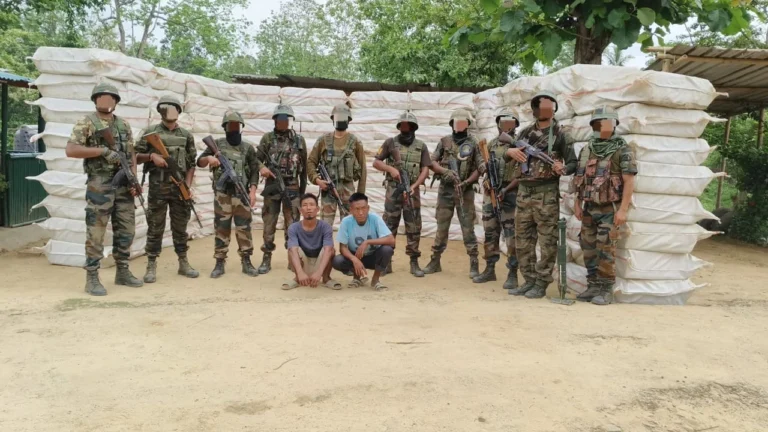One Arrested for Abduction of Two Non-Locals, Victims Rescued Safely: A Comprehensive Look at the Incident and Its Implications
Group 1: News Summary
In a recent incident that has captured local attention, law enforcement officials arrested an individual accused of abducting two non-local victims. The victims were rescued safely, and the suspect is now in custody. This decisive action by the authorities highlights both the critical role of vigilant policing and the community’s collective commitment to ensuring public safety.
Group 2: In-Depth Analysis of the Abduction Incident and Its Wider Implications
Introduction
Hey there, dear reader! Today, we’re diving into a story that has sparked considerable discussion and concern in our community. Imagine waking up to news that someone you barely knew was targeted by an abductor, only to find out that swift police action led to their safe recovery. It sounds like a scene from a thriller, doesn’t it? Yet, this is the reality many non-local victims faced in a recent incident where one individual was arrested for abducting two people. So, what really went down, and what does this tell us about our current safety landscape? Let’s break it down step by step in a way that’s both engaging and enlightening.
The Incident: A Timeline of Events
To truly understand the gravity of this situation, we must first retrace the timeline of events. On a seemingly ordinary day, alarm bells rang when authorities received a tip-off regarding suspicious activity involving two non-local individuals. Reports indicated that these victims, who were not originally from the area, had been targeted by a person with potentially dangerous intentions. The tip-off came from an observant citizen, reminding us that sometimes, community vigilance plays a crucial role in thwarting criminal plans.
From the moment the tip was received, law enforcement swung into action. Officers meticulously traced the movements and connections leading up to the abduction. It wasn’t long before they identified a suspect whose actions and whereabouts raised red flags. With coordinated efforts and swift mobilization, the police intervened at just the right moment, rescuing the victims and apprehending the suspect before any further harm could occur.
Rescue Operation and Ensuring Victim Safety
One of the most heartening aspects of this case is how the rescue operation unfolded. The primary focus of any such intervention is the safety and well-being of the victims, and that’s precisely what happened here. As soon as the police identified the situation, they prioritized the safe extraction of the abducted individuals from a potentially dangerous environment.
Think of it like a game of chess, where every move must be calculated and precise. The law enforcement team worked like a well-oiled machine, with each member playing a critical role in ensuring that the rescue operation was smooth and efficient. Emergency responders, trained in crisis management, were on standby to provide any necessary medical attention and emotional support. Their readiness not only minimized the immediate risk but also helped alleviate the trauma that often accompanies such incidents.
The Arrest: Bringing the Suspect to Justice
Once the victims were safe, the focus shifted to apprehending the person responsible for the abduction. The suspect, now in police custody, is facing charges that could carry severe penalties. The arrest wasn’t merely a punitive measure—it was a powerful statement that unlawful actions will be met with unwavering resolve.
Imagine a scenario where every step taken by criminals is countered by a meticulous strategy from law enforcement. That’s exactly what happened here. The police not only ensured the safe recovery of the victims but also gathered critical evidence against the suspect. This evidence will be vital in ensuring that justice is served and that similar future incidents can be prevented.
Understanding Abduction in Today’s Context
Let’s pause for a moment and consider what abduction means in our modern world. Abduction isn’t just a headline or a statistic; it’s a violation of personal security and trust. When non-local individuals become targets, it raises serious questions about how prepared our communities are to protect everyone, regardless of where they come from. The abduction of non-local victims often leaves the community grappling with feelings of vulnerability and unease.
Abductions can stem from various motives—ranging from ransom demands to personal vendettas, or even as a precursor to other criminal activities. In our increasingly mobile and interconnected society, the movement of people across regions is more frequent than ever. Unfortunately, this also means that criminals have broader targets, sometimes preying on those who are unfamiliar with local customs or security measures.
The Role of Local Law Enforcement
The effectiveness of local law enforcement in handling this case is a testament to their relentless efforts and commitment to public safety. Officers are often the unsung heroes, working long hours and putting themselves at risk to maintain peace and order. In this incident, their proactive approach, combined with a keen sense of duty, ensured that the situation was contained before it escalated.
Local police departments have been enhancing their capabilities through continuous training, the incorporation of modern technology, and the development of strategic partnerships with communities. In our case, a simple tip-off transformed into a rapid response that neutralized a potential threat. This isn’t just luck—it’s the result of diligent work, robust training, and a community that is invested in its own safety.
Community Vigilance and Its Impact
Have you ever heard the saying, “It takes a village”? This incident perfectly encapsulates that sentiment. The alert from a concerned citizen was instrumental in preventing what could have been a far more tragic outcome. It highlights how each member of the community can serve as a guardian of safety by being alert and reporting anything out of the ordinary.
Community vigilance goes beyond mere observation—it’s about fostering a culture where everyone feels responsible for one another’s well-being. When we keep our eyes open and share our concerns with local authorities, we create a network of protection that can deter criminals from exploiting any weaknesses. This case serves as a reminder that every individual, regardless of their background, can contribute to a safer society.
Analyzing the Abduction: What Went Wrong?
It’s crucial to delve into the factors that allowed this abduction attempt to occur in the first place. Several underlying issues may have contributed to the incident, and understanding them is key to preventing future occurrences. Some of these factors include:
- Lack of Awareness:
Often, non-local victims may not be as familiar with the local safety protocols or the environment, making them more vulnerable to such crimes. - Inadequate Security Measures:
In some cases, gaps in community security or insufficient surveillance in public spaces can provide opportunities for criminals. - Social Engineering:
Abductors sometimes use deceptive tactics, building trust or feigning friendship before executing their plan. This manipulation preys on human emotions and lowers the victims’ guard. - Opportunistic Crimes:
Criminals often strike when they sense an opportunity—when there’s a moment of distraction or when security is perceived to be lax.
By addressing these issues through education, improved security measures, and stronger community networks, we can create an environment that is less hospitable to such criminal activities.
The Psychological Impact on the Victims
While the physical safety of the victims was ensured, it’s important to acknowledge the psychological toll such an ordeal can have. Being abducted is a traumatic experience that can leave deep emotional scars. The victims might experience anxiety, mistrust, and even post-traumatic stress, which can affect their daily lives long after the incident.
Imagine a beautiful vase that, once shattered, can never quite regain its original form. Similarly, even after rescue, the emotional damage from an abduction can take time to heal. That’s why psychological support is as vital as the physical rescue. Counseling services, support groups, and ongoing therapy can help the victims navigate the aftermath of such a harrowing experience and rebuild their confidence in the world around them.
Preventive Measures: How Can We Protect Ourselves?
You might be wondering, “What can I do to stay safe and prevent such incidents?” It’s a valid question, and the answer lies in a combination of personal vigilance and community cooperation. Here are some practical steps that both residents and non-locals can take to protect themselves:
- Stay Informed:
Knowledge is power. Familiarize yourself with local safety guidelines and be aware of any recent incidents in your area. This awareness can help you identify and avoid potential threats. - Trust Your Instincts:
If something feels off, it probably is. Don’t dismiss your gut feelings—report any suspicious activity to the local authorities immediately. - Strengthen Community Bonds:
Get involved in neighborhood watch programs or community safety groups. The stronger the community network, the quicker any red flags can be raised and addressed. - Use Technology Wisely:
In today’s digital age, there are numerous apps and platforms designed to enhance personal safety. Whether it’s sharing your location with trusted contacts or using safety apps that send alerts in emergencies, technology can be a great ally. - Educate Yourself and Others:
Attend safety workshops or seminars that focus on personal security and self-defense. Knowledge shared is knowledge multiplied—by educating yourself, you also empower those around you.
Law Enforcement Strategies and Future Readiness
The successful resolution of this incident is a clear indicator of the evolving strategies employed by law enforcement agencies. With the rise in crimes that target vulnerable individuals, it’s imperative that the police stay one step ahead. Here are some strategies that have proven effective:
- Rapid Response Teams:
Special units are being trained to respond swiftly to abduction and kidnapping cases. Their speed and efficiency can make all the difference between a successful rescue and a tragic outcome. - Advanced Surveillance:
Modern technology such as CCTV cameras, drones, and data analytics tools are increasingly becoming integral to policing. These tools help in monitoring public areas and quickly identifying suspicious behavior. - Community Outreach Programs:
Regular engagement with local communities builds trust and encourages residents to report potential threats. Workshops, safety drills, and informational campaigns not only educate the public but also foster a spirit of cooperation between citizens and law enforcement. - Inter-Agency Coordination:
Criminal activities often span across regions and jurisdictions. Effective coordination between local police, regional security agencies, and even national bodies ensures that intelligence is shared and resources are mobilized when needed. - Continuous Training:
The landscape of crime is constantly evolving, and so must the training of police personnel. Regular updates on tactics, technology, and emerging criminal patterns help keep law enforcement prepared for any eventuality.
Societal Impact: Building Trust in a Safer Future
Every incident like this serves as both a warning and an opportunity. While it exposes vulnerabilities in our systems, it also provides a catalyst for change. When the police successfully rescue victims and apprehend criminals, it reinforces public confidence in our safety networks. Trust in law enforcement is not built overnight—it grows through consistent, effective actions that demonstrate a commitment to protecting every member of the community.
Consider the analogy of a well-maintained bridge. Regular inspections, repairs, and reinforcements ensure that the structure remains safe and reliable. Similarly, a society that prioritizes safety and trust will continually invest in its security measures and community support systems, ensuring that every citizen feels protected and valued.
The Broader Context: Abduction Trends in Today’s World
While our focus has been on this particular incident, it’s important to recognize that abductions, especially involving non-locals, are a global concern. In today’s interconnected world, criminals are not limited by borders. With increased travel and migration, individuals can become targets far from home, making awareness and preparedness even more critical.
Many regions have experienced similar incidents, and lessons learned from international cases can help shape local strategies. For example, countries that have successfully reduced abduction rates often emphasize multi-agency cooperation, public awareness campaigns, and the use of cutting-edge technology in policing. These strategies not only help in prevention but also ensure that when incidents do occur, the response is swift and effective.
Economic and Social Ramifications
Beyond the immediate safety concerns, incidents like these can have broader economic and social implications. When abduction attempts make headlines, they can impact tourism, business investments, and overall community morale. A community that is perceived as unsafe can experience a decline in economic opportunities, as both locals and outsiders may hesitate to engage in social or commercial activities.
On the flip side, a prompt and effective response from law enforcement can mitigate these negative impacts. By ensuring that criminals are brought to justice and victims are cared for, local authorities can restore faith in the safety of the community. It’s a reminder that security isn’t just about preventing crime—it’s also about fostering an environment where economic growth and social harmony can flourish.
Lessons Learned and the Way Forward
Every challenge brings with it valuable lessons. This recent incident teaches us several important points:
- The Power of Community:
It takes the vigilance of even one person to tip the scales toward safety. Community members are the eyes and ears that can alert authorities before a situation spirals out of control. - Importance of Preparedness:
Both law enforcement agencies and individuals must be prepared for unexpected situations. Regular drills, updated training, and effective communication channels can make all the difference. - Leveraging Technology:
In our fast-paced world, technology is a double-edged sword. While criminals may exploit digital tools to evade capture, law enforcement agencies are also harnessing these same technologies to protect citizens. - Building Resilience:
The psychological and social impact of crimes like abduction can be long-lasting. Investing in support systems for victims and creating a resilient community mindset is essential for long-term safety.
Concluding Thoughts
As we reflect on this incident, it becomes clear that every arrest, every rescue, and every community alert serves as a building block for a safer future. While the shadow of abduction can loom large, the collective efforts of law enforcement, community members, and supportive networks illuminate the path to justice and healing.
So next time you hear about an abduction case in the news, remember that behind every headline is a story of vigilance, resilience, and hope. Our communities are not just passive victims; they are active participants in the quest for safety. With every successful intervention, we reaffirm our commitment to a society where every individual, local or non-local, can feel secure and valued.
Let’s continue to work together, stay informed, and build bridges of trust and cooperation. After all, the safety of one is the safety of all.
FAQs
- What happened in the recent abduction incident involving non-local victims?
An individual was arrested after abducting two non-local victims. Thanks to prompt police action, the victims were rescued safely, and the suspect was taken into custody. - How did the community contribute to resolving the incident?
A vigilant citizen’s tip played a crucial role in alerting the authorities, highlighting the importance of community vigilance and active participation in public safety. - What measures did law enforcement employ to ensure the victims’ safety?
Law enforcement used a coordinated rapid response strategy, advanced surveillance, and emergency intervention to rescue the victims and apprehend the suspect before the situation could escalate. - What steps can individuals take to protect themselves from similar crimes?
Staying informed, trusting your instincts, engaging in community watch programs, and utilizing safety apps and technology are practical ways to enhance personal security and prevent potential abduction attempts. - What broader implications does this incident have for public safety and community trust?
This incident underscores the need for robust law enforcement, community cooperation, and continuous improvement in security measures. It serves as a reminder that together, we can build a safer, more resilient society.





